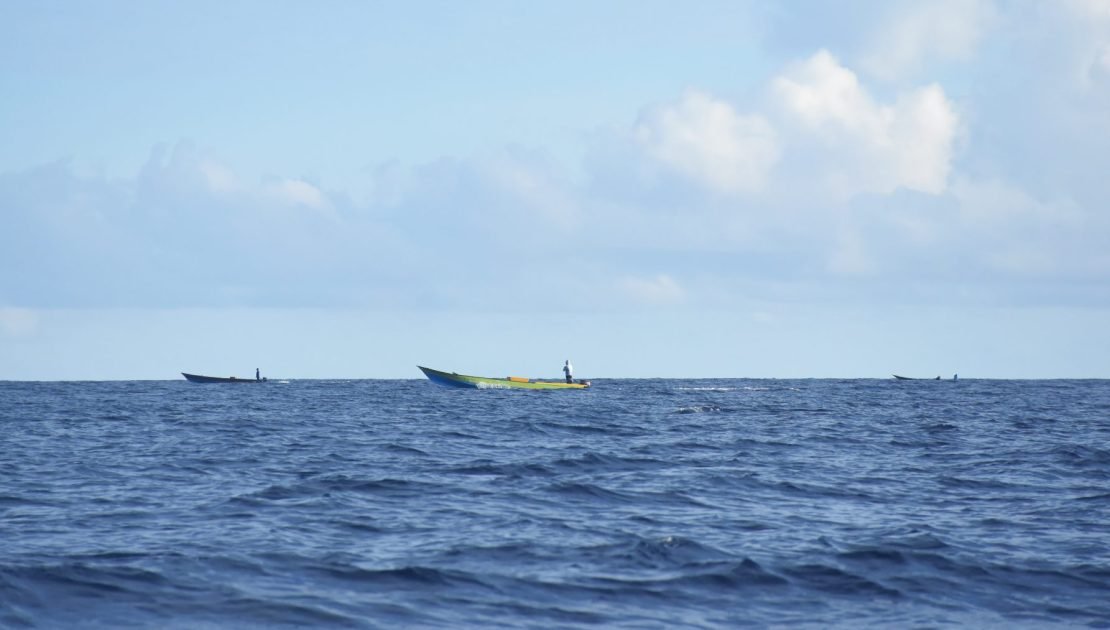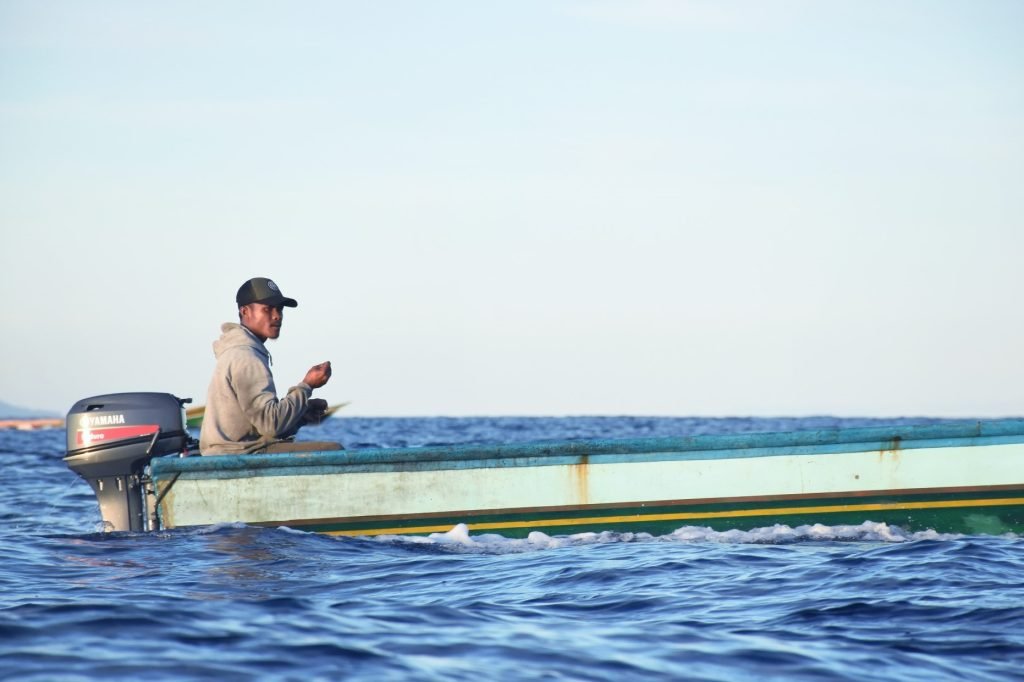
Data collected MDPI so far indicates that the size of tuna caught in the last few years has been in decline, with fishers needing to travel further out, resulting in longer fishing days and increased fuel costs. These signs of declining catch volumes need to be monitored, especially by small-scale fishers, who are living with many limitations as is. Many of them have no alternative source of income; they cannot afford to keep paying the high operational cost of fishing only to return with too little catch, if any.
Fair Trade Fisher Associations in Maluku and North Maluku recently celebrated World Fisheries Day 2021 on November 21st, along with the rest of fishery communities around the globe. This year, they called out to fellow small-scale fishers to consider taking a one-day break from fishing each week, or a total of 52 days a year. This effort is intended to help reduce fish mortality, allowing more time for fish to grow and breed, to help naturally restore fish stocks in the sea.
Agustina Nilam Ratnawati, MDPI’s Fisheries Community Organization Manager, responsible for the Fair Trade USA program implementation in Maluku and North Maluku, stated that in the eight years that this program has been running in Maluku and North Maluku, there have been many lessons learned by everyone involved. “Meeting all the Fair Trade certification standards is no easy feat; when we first started, the prospect of receiving Premium Funds was the biggest buy-in for most of these fishers,” she reflected.
The Fair Trade Premium Fund itself is received by Fair Trade Committees based on the amount of fish that they export, which are then disbursed to each fisher association within their jurisdictions. Fish sold through the Fair Trade supply chain will get them USD 0,2 (around IDR 3,000) per kilogram of the total volume exported. These funds are allocated for environmental and social purposes, divided 30% and 70% respectively, including for operational costs of each association. However, to receive this Premium Fund, fishers must undertake new responsibilities, many of which they were not familiar with, such as logging their fishing trips, conducting and attending group meetings, organizing, and adopting sustainable and responsible fishing practices to protect biodiversity thus ensuring fishing resources for future generations. Getting all this right requires not only time, but also perseverance, in providing the required assistance and guidance for fishers.
A handful of external circumstances could also threaten the continuation of this certification, such as market dynamics, sales, pricing, and regulations that do not always benefit small-scale fishers, which tend to result in loss of trust in the process, and discourage fishers from wanting to maintain hold of their certification. Moreover, natural conditions are not always favorable and can dishearten even the most committed fisher from continuing their efforts, in order to make ends meet.
“In the sixth year of certification, Fair Trade fisher associations are more capable in resolving issues independently. However, they have only started writing reports and engaging with processing factories,” Nilam adds. Six years of certification is deemed insufficient when it comes to maximizing the capacity of each association; this period is mostly dedicated to identifying fishers that are truly committed in participating in the whole process. Only a few select people have been able to commit and manage their groups in a way that allows for consistent progress.


Since fishers rely heavily on the ocean, there are important factors that need to be taken into consideration to ensure sufficient amount of catch. Fishing activities must be regulated and carried out in environmentally friendly ways, with minimal-to-no impact on the ocean’s protected species such as dolphins, turtles, and sharks, as well as keeping the ocean free from fishing-related waste, while adhering to other sustainable fishing principles.
Gafur Kaboli, a Fair Trade fisher from Jambula village in Ternate who has been tapped by MDPI to “champion” sustainable fishing in the region, is able to articulate the current situation to his fisher colleagues. MDPI’s I-Fish data in 2014 shows that tuna caught in the 714 and 715 fishing zones were plentiful and measured up to 170 cm. But in 2020, the opposite was observed, where handline tuna fishers are catching smaller and smaller fish. “What is going on? Is there a problem with the ocean? Sure, tuna migrates, but overfishing is happening, too,” notes Gafur, who also currently leads 25 other members of Marimoi Fisher Association in Jambula.
With regards to natural fish stocks, MDPI’s Fisheries Program Manager, Wildan, believes that Indonesia has great potential in capture fisheries, specifically for yellowfin tuna (Thunnus albacares) and skipjack (Katsuwonus pelamis). As a frequent technical workshop attendee, he has learned that there are currently two conditions for Indonesia’s fishery. “In the Western and Central Pacific Oceans, stock levels are still in a good place, so fishing is still allowed. However, yellowfin tuna in the Indian Ocean management zone is indeed being overfished, hence the need for a stock rebuilding program, which has since been adopted by the Indian Ocean Tuna Commission (IOTC).”



Tuna fishery management and regulation must take into account where the fish are being caught. According to Wildan, “Stock rebuilding programs can restore tuna population back to a healthy number, including by enforcing catch limits in every IOTC member countries.” Insufficient level of fish stocks could also hinder eco-labelling opportunities, seeing as certifications such as Fair Trade and Marine Stewardship Council demand that fish population be restored to a healthy amount.
The role of the Indonesian government is also key in improving fisheries management in the country. MDPI is actively involved in fisheries improvement efforts and can observe the progress made by the government. “They continue to collect data and catch reports, as well as renewing the Management Plan for tuna fisheries. Indonesia is also a full member of tuna Regional Fisheries Management Organizations (tRFMOs) such as the IOTC, Western and Central Pacific Fisheries Commission, Commission for the Conservation of Southern Bluefin Tuna, and is a cooperating non-member of the Inter-American Tropical Tuna Commission,” Wildan explained.
Furthermore, Indonesia is becoming more consistent in implementing the five management measures as part of the Indonesian Tuna Harvest Strategy. The following five priority management measures were selected: Limit on use of Fish Aggregating Device; Spatial closure (of important spawning or nursery grounds) and temporal closure (during important events such as spawning); Number of fishing days (per gear, for semi industrial and industrial vessels); Number of vessels (limited entry per gear, for semi industrial and industrial vessels through licensing, permits, taxing, royalties) and Total Allowable Catch (TAC) limits per Fishery Management Area. Currently, tuna management practices continue to improve and are fully supported through stakeholder communication forums that actively seek ways to increase awareness within the private sector and among fishers, especially toward current regulations and conditions surrounding tuna fisheries.


Though celebrated annually, throughout this year’s World Fisheries Day celebrations MDPI was supported by Fair Trade fishers in ensuring that important issues and messages are conveyed to the community, specifically regarding the critical importance of healthy ocean ecosystems and fish stocks for sustainable fisheries.
Indonesian fishers generally take one day off from fishing per week, usually to clean their boats and, in the case of Muslim fishers, attend Friday prayers. In simple logic, by taking one day of rest per week, one handline tuna fisher could contribute to conserving at least one fish in the sea by not catching it. If the 682 Fair Trade handline fishers spread across Maluku and North Maluku were to rest for one day, they will have kept 682 tuna in the sea each week, equivalent to 17.050 kg (assuming an average weight of 25 kg per fish), or equivalent to 35.464 tuna which totals 886.600 kg per year. There is enough willingness of fishers to legally adopt the one day of rest per week through the development of a village regulation (Peraturan Desa).
The aforementioned numbers illustrate the significant contribution of small-scale fishers toward natural restoration of fish stocks. By taking one-day breaks from fishing, we hope that our fishery resources are also given the time to recover and bounce back naturally, in addition to allowing fishers to rest.
Buku ini disusun untuk mempermudah identifikasi spesies hewan ERS dan ETP yang
berinteraksi dengan nelayan selama aktivitas penangkapan tuna berlangsung. Semua
sumber ilustrasi gambar dan informasi pada buku ini telah dicantumkan pada daftar
referensi.
Kisah dari kampung nelayan kecil di 5 provinsi (NTB, Sulawesi Selatan, Sulawesi Utara, Maluku, Maluku Utara) diceritakan oleh masyarakat dampingan dan para pendamping MDPI. Mimpi besar untuk menjangkau lebih luas masyarakat pesisir dengan berupaya pada peningkatan kesejahteraan nelayan kecil melalui pengembangan kapasitas, membangun kemandirian, dan ketahanan ekonomi serta memperkuat institusi lokal demi mendukung perikanan berkelanjutan. Banyak pengalaman inspiratif, cerita sukses, kendala, kritikan, rasa bangga dan haru bercampur aduk dikisahkan dalam buku ini.
Penulis:
Gede Sughiarta, Nilam Ratna, Arroyan Suwarno, Alief Dharmawan,
Adjie Dharmasatya, Hairul Hadi, Muhammad Taeran, Muh. Alwi, Sahril,
Siti Zuleha, Sri Jalil, Hizran Sampalu, Karel Yerusa, Novita Ayu Wulandari,
M. Subhan Moerid.
Penyunting:
Gede Sughiarta, Arroyan Suwarno, Nilam Ratna, Alief Dharmawan
Desain/Layout:
Gede Sughiarta
Foto:
Yayasan MDPI, Gede Sughiarta
Illustrasi:
Panca Kumara